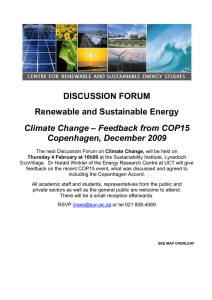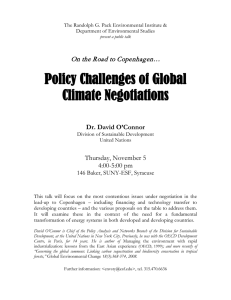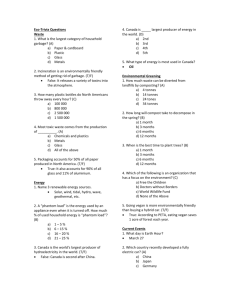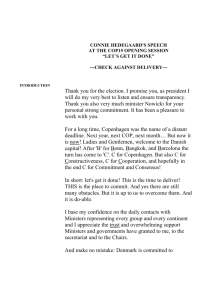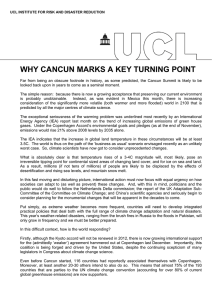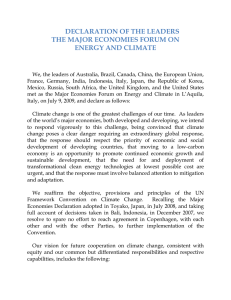briefing Copenhagen’s climate finance promise: six key questions
advertisement
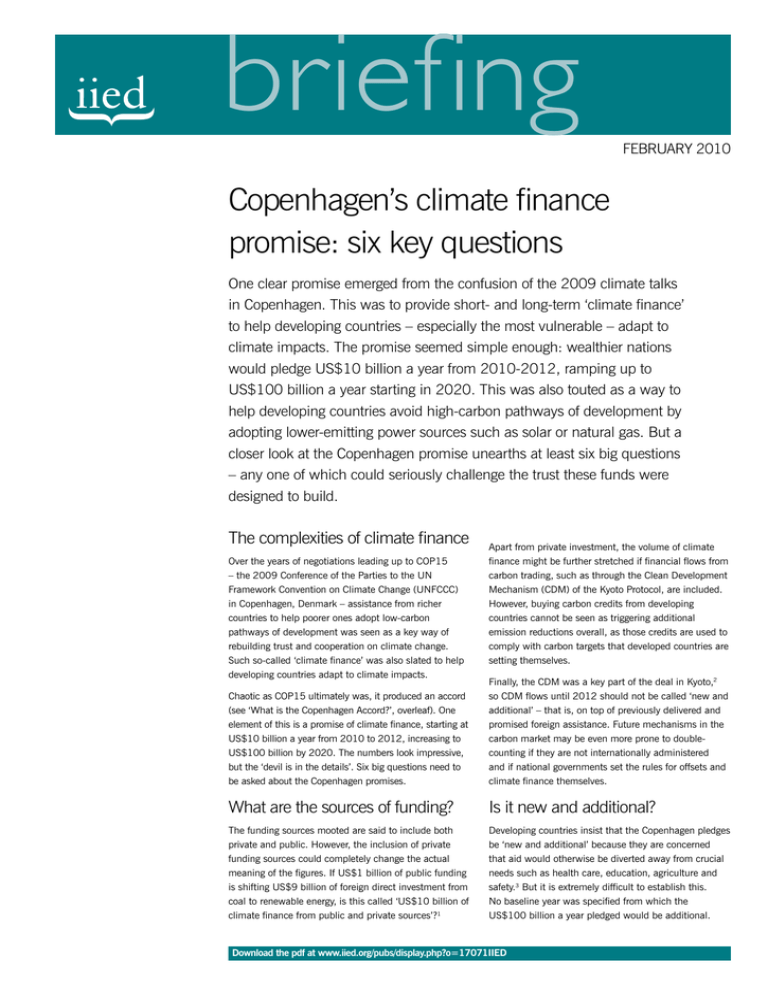
briefing february 2010 briefing Copenhagen’s climate finance promise: six key questions One clear promise emerged from the confusion of the 2009 climate talks in Copenhagen. This was to provide short- and long-term ‘climate finance’ to help developing countries – especially the most vulnerable – adapt to climate impacts. The promise seemed simple enough: wealthier nations would pledge US$10 billion a year from 2010-2012, ramping up to briefing US$100 billion a year starting in 2020. This was also touted as a way to help developing countries avoid high-carbon pathways of development by adopting lower-emitting power sources such as solar or natural gas. But a closer look at the Copenhagen promise unearths at least six big questions – any one of which could seriously challenge the trust these funds were designed to build. The complexities of climate finance Over the years of negotiations leading up to COP15 – the 2009 Conference of the Parties to the UN Framework Convention on Climate Change (UNFCCC) in Copenhagen, Denmark – assistance from richer countries to help poorer ones adopt low-carbon pathways of development was seen as a key way of rebuilding trust and cooperation on climate change. Such so-called ‘climate finance’ was also slated to help developing countries adapt to climate impacts. Apart from private investment, the volume of climate finance might be further stretched if financial flows from carbon trading, such as through the Clean Development Mechanism (CDM) of the Kyoto Protocol, are included. However, buying carbon credits from developing countries cannot be seen as triggering additional emission reductions overall, as those credits are used to comply with carbon targets that developed countries are setting themselves. Chaotic as COP15 ultimately was, it produced an accord (see ‘What is the Copenhagen Accord?’, overleaf). One element of this is a promise of climate finance, starting at US$10 billion a year from 2010 to 2012, increasing to US$100 billion by 2020. The numbers look impressive, but the ‘devil is in the details’. Six big questions need to be asked about the Copenhagen promises. Finally, the CDM was a key part of the deal in Kyoto,2 so CDM flows until 2012 should not be called ‘new and additional’ – that is, on top of previously delivered and promised foreign assistance. Future mechanisms in the carbon market may be even more prone to doublecounting if they are not internationally administered and if national governments set the rules for offsets and climate finance themselves. What are the sources of funding? Is it new and additional? The funding sources mooted are said to include both private and public. However, the inclusion of private funding sources could completely change the actual meaning of the figures. If US$1 billion of public funding is shifting US$9 billion of foreign direct investment from coal to renewable energy, is this called ‘US$10 billion of climate finance from public and private sources’?1 Developing countries insist that the Copenhagen pledges be ‘new and additional’ because they are concerned that aid would otherwise be diverted away from crucial needs such as health care, education, agriculture and safety.3 But it is extremely difficult to establish this. No baseline year was specified from which the US$100 billion a year pledged would be additional. Download the pdf at www.iied.org/pubs/display.php?o=17071IIED What is the Copenhagen Accord? The Copenhagen Accord is an international agreement among 25 nations attending the UN Framework Convention on Climate Change Conference of the Parties (COP15). The 193 countries at COP15 agreed to ‘take note’ of the Accord. It includes all the major issues debated in the negotiations leading to the event – such as mitigation, adaptation, financing and technology – but is not legally binding like the Kyoto Protocol or other treaties. Paragraphs 8 to 10 cover finance. 8. S caled up, new and additional, predictable and adequate funding as well as improved access shall be provided to developing countries, in accordance with the relevant provisions of the Convention, to enable and support enhanced action on mitigation, including substantial finance to reduce emissions from deforestation and forest degradation (REDD-plus), adaptation, technology development and transfer and capacity-building, for enhanced implementation of the Convention. The collective commitment by developed countries is to provide new and additional resources, including forestry and investments through international institutions, approaching USD 30 billion for the period 2010 to 2012 with balanced allocation between adaptation and mitigation. Funding for adaptation will be prioritized for the most vulnerable developing countries, such as the least developed countries, small island developing States and Africa. In the context of meaningful mitigation actions and transparency on implementation, developed countries commit to a goal of mobilizing jointly USD 100 billion dollars a year by 2020 to address the needs of developing countries. This funding will come from a wide variety of sources, public and private, bilateral and multilateral, including alternative sources of finance. New multilateral funding for adaptation will be delivered through effective and efficient fund arrangements, with a governance structure providing for equal representation of developed and developing countries. A significant portion of such funding should flow through the Copenhagen Green Climate Fund. 9. T o this end, a High Level Panel will be established under the guidance of and accountable to the Conference of the Parties to study the contribution of the potential sources of revenue, including alternative sources of finance, towards meeting this goal. 10.We decide that the Copenhagen Green Climate Fund shall be established as an operating entity of the financial mechanism of the Convention to support projects, programme, policies and other activities in developing countries related to mitigation including REDD-plus, adaptation, capacity-building, technology development and transfer. Also unspecified was how a baseline would be set – as a single-year amount of aid, or an average of several years? Assessing the additionality of funds is even more difficult, as there is substantial overlap between climate change projects and typical development aid. Particularly in the case of adaptation projects, many of the actions taken to prepare for climate impacts are identical to those many countries have been putting into practice for years. Diversifying economies, shifting from drought-sensitive crops, building irrigation systems, moving wells away from salty groundwater along coasts – all of these make sense both as adaptation and as projects enabling development. In fact, some experts and practitioners have argued that good development is the same as good adaptation. This, Copenhagen’s climate finance promise: six key questions however, is an extremely broad view of adaptation, and critics may argue that it renders any accounting of new and additional funding nearly impossible. Distinguishing between old ‘development projects’ and new ‘mitigation projects’ counted under Copenhagen to reduce greenhouse gas emissions is also surprisingly difficult. Since the energy crises in 1973 and 1978, countries in the developing world have received assistance from national aid agencies such as USAID and German development bank KfW, and international financial institutions such as the World Bank, for projects like shifting coal-fired power plants to natural gas.4 Are new instances of these same projects suddenly promoted because of climate change therefore new and additional? Seemingly some would need to be included in the baseline above which new and additional funds would be counted. Who decides? Another crucial element in deciding how climate finance is defined is who is responsible for the defining. Just before COP15, a proposal was made by members of the Organisation for Economic Co-operation and Development (OECD) Development Assistance Committee (the DAC). They proposed that climate funding could be captured with their so-called ‘Rio Markers’ system to categorise mitigation projects, briefing briefing and their new ‘Adaptation Markers’ to track new and additional funding.5 These markers are quite simple labels, categorising a project as having climate change as its ‘principal’ or as a ‘significant’ objective. There must be a broader international agreement on whether either or both of these categories allow a project to count as ‘new and additional’; probably comprehensive lists of types of projects that can be counted in each category will need to be developed. Most of all, there needs to be much more inclusive understanding and discussion about the way the markers categorise projects. briefing And who categorises each project? Under the OECD DAC system, donors define their own projects as climate-related or not. In some donor agencies, project managers assign these codes – allowing someone with good knowledge to make the decision. However, each may have different ways of interpreting ‘climate-related’. Some agencies have a central office ‘DAC reporter’ or staff assigning codes to projects. These reporters are often overworked and under-resourced, and may be under pressure to determine spending in each category to satisfy the ‘new and additional’ criterion. Grants or loans? The Accord is unclear on whether the promised new climate finance includes mostly grants, or also a major fraction of loans. This is important: many loans extended by major international agencies like the International Monetary Fund are not that different from commercial sector loans. Will the calculus of ‘new and additional funding’ only count the ‘concessional’ portion of the loan – the extent to which the terms beat commercial loans these countries could get? (This is called the ‘grant element’ by the OECD DAC.) Or will traditional official development assistance (ODA) accounting rules apply, where the full amount is counted when it is dispersed, but then accounts to zero once fully paid back? Most analyses use only the ‘commitments’, and do not subtract the repayments. The risk is that by counting loans as part of climate finance, what is actually being counted is funds that flow back to lenders. Depending on the definition, US$10 billion of new climate finance may actually mean very little additional support. How predictable? There are also issues of predictability and pace of implementation. How long will it take for developing countries to receive first funds from the Copenhagen promises? Looking at past experience with ODA and climate funding, it may take several years to disburse even the ‘fast track’ finance promised for 2010 to 2012. So financing sources independent of short-term politics, as well as an efficient approval process, are needed. Which channels? Regarding the pace of implementation, what agencies will be making the key decisions, and will they be effective and streamlined in granting the go-ahead for climate projects? Fair governance systems for these long-awaited climate funds – and equitable policies for their dispersal – are critical for their legitimacy among developing nations.6 Two essential tasks All six questions call for two essential tasks to be fulfilled on an international level. nThere must be clarity and broad agreement about the definition of what the billions in climate finance actually stand for, especially how much will be public money; how ‘new and additional’ is to be defined; and how concessional loans have to be in order to count. nTransparency, oversight and evaluation on how much is actually paid, where the funding is going and what it is being used for will be critical to the sustainability of these funds. Certainly there will need to be a registry with rules set by the parties to the UNFCCC, as well as an Oversight Board (or High Level Panel, as set out in the Accord – see paragraph 9 in ‘What is the Copenhagen Accord?’, opposite). However, the mandate of this panel is only to study, not to verify or enforce climate finance. Following clear guidelines such as the ones under the new International Aid Transparency Initiative (IATI) – which seeks to bring donors together with developing countries’ governments, civil society organisations and others to agree common standards on information regarding all aid flows – could help the panel (as well as people in the financing chain) to understand what is being done where, and what the money is meant to be spent on (see ‘The push for aid transparency’). If the pledges are not being met, there needs to be a mechanism to effectively raise and distribute more funds. The push for aid transparency The new International Aid Transparency Initiative (IATI) is now working on common information standards for all aid flows, covering: 1. agreement on what will be published, for example detailed project information, expected outputs and outcomes, and conditions 2.common definitions for sharing information, to enable better comparability between donors and countries 3. a common electronic data format, that will facilitate the sharing of aid information, and reduce transaction costs 4. a code of conduct setting out what donors commit to publishing, how this will be made available, and how donors will be held accountable for compliance. briefing briefing Transparency, oversight and evaluation are also warranted for the performance of the financed projects. So major improvements in existing practice are needed, as the performance of existing internationally funded mitigation and adaptation projects is not well charted. such as sea-level rise, droughts, flooding and rising temperatures. On the other hand, if humanity is going to avoid the worst of these impacts, developing countries need to mitigate their emissions by following a lowcarbon development path. A valuable initial effort would be to systematically review which past projects classified as mitigation and adaptation actually resulted in real and additional mitigation and adaptation activities. Rigorous independent evaluation of project outcomes, connected to systems to reprioritise those types of projects that are most successful, could drive major improvements in climate finance. To do this while meeting their needs for growth demands major energy efficiency measures, switching to low-carbon energy sources, or reducing deforestation. While the need for climate finance in developing countries is disputed, it is estimated to amount to US$100-250 billion a year by 2030 (see Table below). briefing Table. Recent estimates of international climate finance Annual funding needs, 2005 (billions of dollars) Financing a future The six points raised here suggest that the bare figures in the Copenhagen Accord mean little for the future of climate financing. These climate finance flows must be further distinguished from other flows, especially regarding additionality, public or private flows, timing and authority. A new system of oversight also needs to be created under UN guidance in coordination with the OECD DAC, to guarantee the needed transparency. The oversight should consist of both a registry as well as an Oversight Board with a broader mandate than the High Level Panel as it was set out in the Accord. That mandate needs to include impact evaluation, verification and enforcement. And how much funding will be needed to help developing countries address climate change? This is a tough call, but any prediction must address two sets of needs. On the one hand, Least Developed Countries (LDCs) in particular have to adapt to devastating climate impacts Source Year Mitigation Adaptation EC (2009) 2020 94* 10-24 African Group (2009) 2020 200 >67 World Bank (2009) 2030 139-175 20-100 UNFCCC (2008) 2030 >65 28-59 * However, only US$12-26 billion should come from international public funding, while the rest would come from developing countries and carbon markets. nJ. Timmons Roberts, Martin Stadelmann and Saleemul Huq J. Timmons Roberts is Director of the Center for Environmental Studies at Brown University, US; Martin Stadelmann is researcher at the Center for International and Comparative Studies, ETH and University of Zurich, and project manager at myclimate, Switzerland. This briefing represents the views of the authors and not necessarily those of their institutions. Further reading & websites Algeria (on behalf of the African Group). 2009. Key Elements of LCA Negotiation Text (final version). See http://unfccc.int/files/ meetings/ad_hoc_working_groups/lca/application/pdf/african_group_submission_lca_april_2009.pdf. n EC. 2009. Stepping Up International Climate Finance: A European blueprint for the Copenhagen Deal. EC, Brussels. See http://ec.europa.eu/environment/ climat/pdf/future_action/com_2009_475.pdf. n GEF. 2009. Report of the GEF to the Fifteenth Session of the Conference of the Parties to the United Nations Framework Convention on Climate Change. GEF, Washington DC. n UNFCCC. 2008. Investment and Financial Flows to Address Climate Change: An update. UNFCCC, Bonn. n World Bank. 2009. World Development Report 2010. World Bank, Washington DC. Notes n 1 This roughly 10 to 1 ratio of ‘leveraged funds’ to direct contributions is routinely reported by the GEF for existing climate aid flows. See, for example, GEF. 2009. Report of the GEF to the Fifteenth Session of the Conference of the Parties to the United Nations Framework Convention on Climate Change. GEF, Washington DC. n 2 Roberts, J. T. and Parks, B.C. 2007. A Climate of Injustice: Global inequality, North-South politics, and climate policy. MIT Press, Cambridge, US. n 3 This issue has also been raised by academic scholars (Michaelowa, A. and Michaelowa, K. 2007. Climate or development: is ODA diverted from its original purpose? Climatic Change. 84:5-21). n 4 Hicks, R. L. et al. 2008. Greening Aid? Understanding the environmental impact of development assistance. Oxford University Press, Oxford. n 5 OECD. 2009. OECD Development Assistance Committee Tracks Aid in Support of Climate Change Mitigation and Adaptation. Information Note. OECD, Paris. n 6 Müller, B. 2009. Institutional Arrangements for Climate Finance. Working Paper. Oxford Institute of Energy Studies, Oxford. Download the pdf at www.iied.org/pubs/display.php?o=17071IIED The International Institute for Environment and Development (IIED) is an independent, nonprofit research institute working in the field of sustainable development. IIED provides expertise and leadership in researching and achieving sustainable development at local, national, regional and global levels. This briefing has been produced with the generous support of Danida (Denmark), DFID (UK), DGIS (the Netherlands), Irish Aid, Norad (Norway), SDC (Switzerland) and Sida (Sweden). CONTACT: Saleemul Huq saleemul.huq@iied.org 3 Endsleigh Street, London WC1H 0DD, UK Tel: +44 (0)20 7388 2117 Fax: +44 (0)20 7388 2826 Website: www.iied.org International Institute for Institute for Environment and Development International Environment and Development
